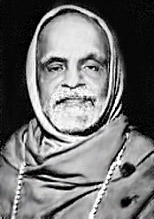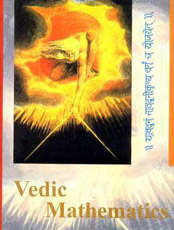 Jagadguru Swami Sri Bharati Krisna Tirthaji, who is described as having the "rare combination of the probing insight and revealing intuition of a Yogi with the analytical acumen and synthetic talent of a mathematician" (Pratyagatmananda, 1965). A hindu scholar and mathematician , Swami Sri Bharati Krisna Tirthaji, presented Vedic Mathematics as a system of mathematics consisting of a list of 16 basic sutras, or aphorisms, that allegedly encompass all mathematics. The calculation strategies are creative and useful provided by Vedic mathematics. This attempt to lebel mathematics as `Vedic` has given rise to great controversy amongst the Indian mathematician. Within the education system, in a number of ways to calculation methods in arithmetic and algebra Vedic mathematics can be applied.
Jagadguru Swami Sri Bharati Krisna Tirthaji, who is described as having the "rare combination of the probing insight and revealing intuition of a Yogi with the analytical acumen and synthetic talent of a mathematician" (Pratyagatmananda, 1965). A hindu scholar and mathematician , Swami Sri Bharati Krisna Tirthaji, presented Vedic Mathematics as a system of mathematics consisting of a list of 16 basic sutras, or aphorisms, that allegedly encompass all mathematics. The calculation strategies are creative and useful provided by Vedic mathematics. This attempt to lebel mathematics as `Vedic` has given rise to great controversy amongst the Indian mathematician. Within the education system, in a number of ways to calculation methods in arithmetic and algebra Vedic mathematics can be applied.
Swami Sri Bharati Krisna Tirthaji was born on March 1884 in India. Swami Sri Bharati Krisna Tirthaji was born to P.Narasimha Shastri, originally a tehsilder in Madras Presidency later became the Deputy Collector of the Presidency. By the age of twenty he had studied at a number of colleges and universities throughout India. He was awarded the title `Saraswati` for his remarkable proficiency in Sanskrit by Madras Sanskrit Association. He won the highest place in the graduation B.A. Sanskrit, Philosophy, English, Mathematics, History and Science are the fields where S.Bharati had completed masters degrees with the American College of Sciences.
Venkatraman Saraswati worked under Gopal Krishna Gokhale in 1905 for the National Education Movement and the South African Indian problems. However, his propencity towards science and Indic studies led him to study the ancient Indian holy scriptures, "Adhyatma-Vidya". After becoming the Shankaracharya of Govardhan Math, Swami Sri Bharati Krisna Tirthaji toured all over the world for 35 years to spread the values of peace, harmony and brotherhood and to spread the message of the Sanatana Dharma. Swami Sri Bharati Krisna Tirthaji remained the Shankaracharya of the Govardhan Matha until his death in 1960.
Swami Sri Bharati Krisna Tirthaji wrote a large number of treatises and books on religion, sciences, mathematics, world peace and social issues. In 1953, Swami Sri Bharati Krisna Tirthaji founded an organization called "Sri Vishwa Punarnirmana Sangha" at Nagpur.
S.Bharati was an exceptional scholar. He determined to study several sections of the "Atharva-Veda" around 1911. His study had been refuted as nonsensical by orientalists, Indologists and antiquarian scholars. S.Bharati claimed that there were sections of the Atharva-veda labelled "ganita sutras" or "mathematical formulae" which was mysteriously made. There is no obvious reference to mathematics. Tirthaji explains that he was determined to understand the "ganita sutra" references, and began studying ancient glossaries and procedures of writing in more detail. With this resolve, Tirthaji went to Sringeri, Karnataka, where he began years of solitary study and meditation.
After eight years, S.Bharati claimed that he made it possible to interprete 16 fundamental mathematical sutras in the Vedas, which today have become the foundation of Vedic mathematics. According to him, the sutras cover every branch of mathematics, from arithmetic to spherical conics, and that "there is no mathematics beyond their jurisdiction".
 After discovering the sutras, he travelled around India in order to represent "Vedic mathematics". In 1958 he lectured in the United States and England. S.Bharati Tirthaji also wrote sixteen volumes, one for each basic sutra, explaining their applications. Unfortunately, before they were published, the manuscripts were irrecoverably lost. Before falling ill and passing away in 1960, Tirthaji was able to rewrite the first of the sixteen volumes he had composed. This, text titled as "Vedic Mathematics" has become the basis for all study in the area.
After discovering the sutras, he travelled around India in order to represent "Vedic mathematics". In 1958 he lectured in the United States and England. S.Bharati Tirthaji also wrote sixteen volumes, one for each basic sutra, explaining their applications. Unfortunately, before they were published, the manuscripts were irrecoverably lost. Before falling ill and passing away in 1960, Tirthaji was able to rewrite the first of the sixteen volumes he had composed. This, text titled as "Vedic Mathematics" has become the basis for all study in the area.
There has been much controversy about Tirthaji`s claims that the mathematics is Vedic and that it encompasses all aspects of mathematics amongst Indian scholars. It was criticised on the basis that none of the sutras can be found in any extant Vedic literature.
In response to the criticism several people have explained how textual references should not be the basis for evaluating the Vedicity of the mathematics. Some proposed that Vedic mathematics is different than other scientific work because it is not pragmatically worked out. It is based on an "intuitional visualisation" of fundamental mathematical truths. S.Bharati has been described as having "reverential approach" towards the Vedas as the ancient rishis formed them.
By the double meaning of veda the controversy about the Vedicity of the mathematics is further confused. Since veda can be translated to mean `knowledge`, it is also possible that Vedic mathematics simply refers to the fact that the sutras are supposed to present all knowledge of mathematics. His definition of Veda does not clearly clarify whether it is to represent all knowledge or the Vedic texts.
The oponents are also worried that Vedic mathematics deviates attention from genuine achievements of ancient and modern Indian mathematics and mathematicians, and that its promotion by Hindu nationalists may damage mathematics education in India. Additionally, the promotion of Vedic Maths as advanced mathematics has drawn criticism from mathematicians. Although quite useful for practical calculations in daily life, some signify that the "tricks" involved have no application to higher mathematics or mathematical research.




















